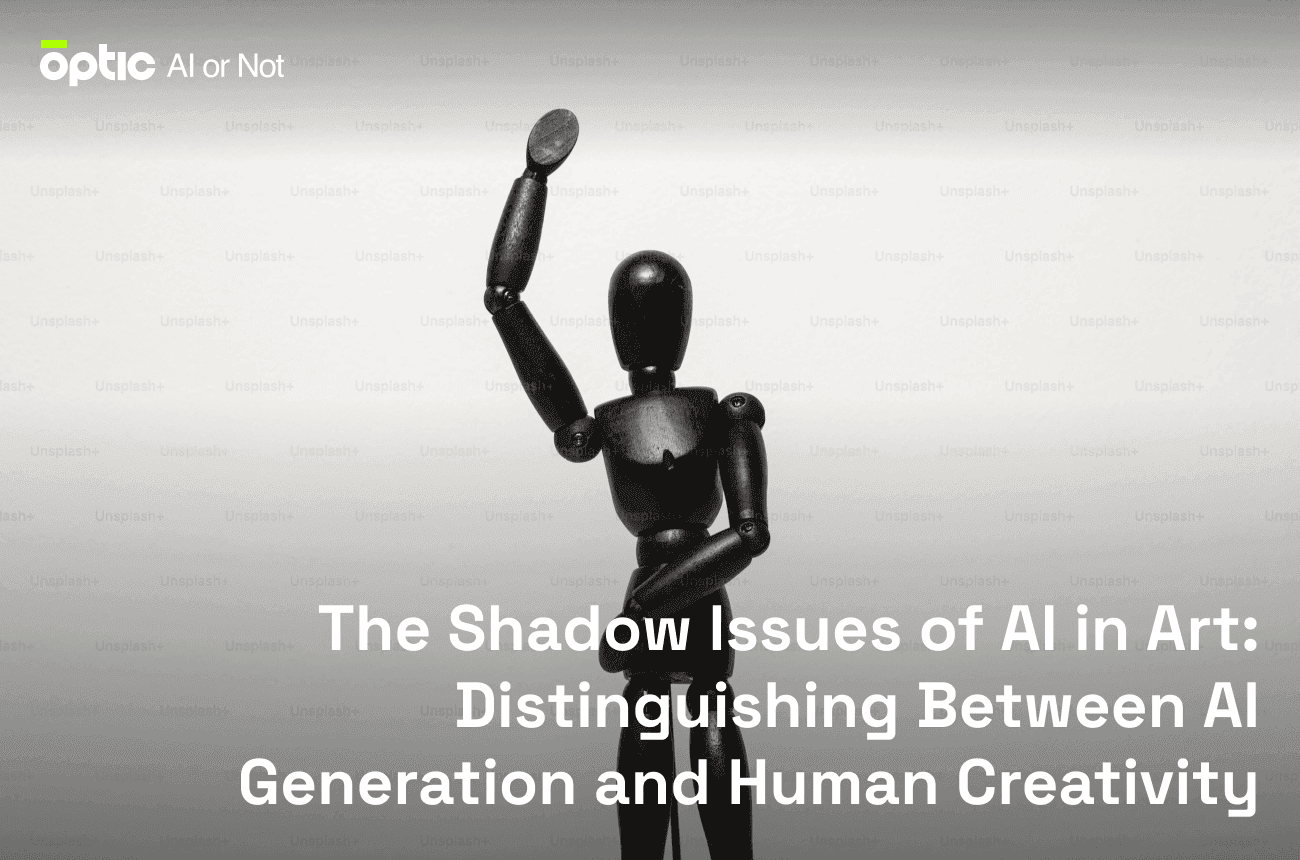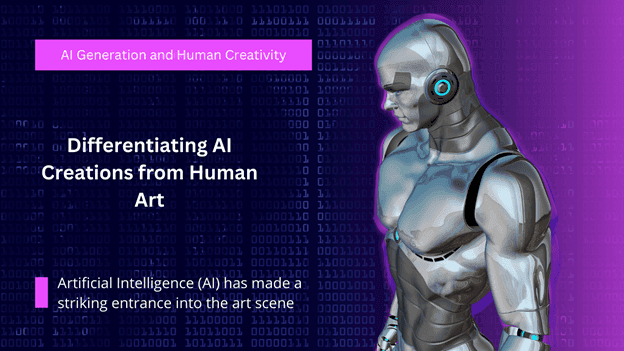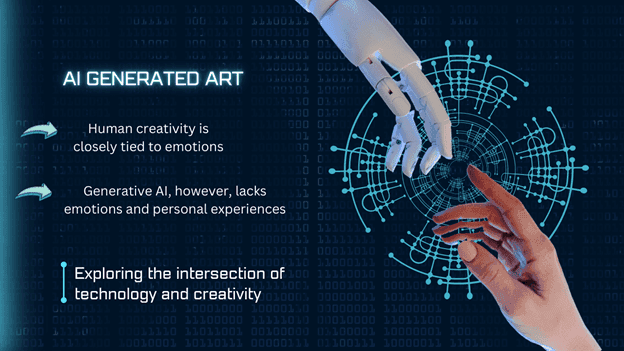The Shadow Issues of AI in Art: Distinguishing Between AI Generation and Human Creativity

Introduction: AI and Its Echo in the Art World
Artificial Intelligence (AI) has made a striking entrance into the art scene, breathing life into AI-generated art. However, this phenomenon casts some shadow issues, chiefly about AI detection in art, differentiating it from human-made artwork and the monetization strategies of "fake artists." In this piece, we'll scrutinize these challenges and illuminate the world of AI art.
Unveiling AI Art: How to Detect AI-Generated Creations
Visual Realism and Mimicry
AI detection in Art presents a significant challenge due to its remarkable visual realism and capacity to imitate human-generated artwork closely. It’s hard to know if the art is human or not AI. The intricate details and authenticity AI algorithms produce to create a blurred line that makes it difficult to distinguish between AI-generated art and human pieces.
AI-produced art can imitate human-made art styles and characteristics so well that even experts may be unable to distinguish between them, highlighting AI's impressive yet potentially misleading abilities.
Evolving AI Techniques
The field of AI is continually evolving, leading to the emergence of more intricate AI-generated art. This necessitates the development of advanced AI detection techniques to keep up with the progress in AI. Staying up-to-date and creating robust AI detection tools to identify AI art accurately is crucial.
We must stay current with the latest techniques to detect AI art via tools like AI-generated art tests and develop effective countermeasures. This ongoing process highlights the "cat and mouse" game between AI technology and those working to prevent misuse.

AI-Generated Art Test: Differentiating AI Creations from Human Art
Artistic Intent and Human Experience
Artistic Intent: Art reflects human emotions and insights. AI-generated art lacks the subjective intention inherent in human art. It arises solely from data-driven algorithms, which cannot replicate the depth and complexity of human emotion.
The fundamental essence of art, which has been revered and cherished throughout history, is its intimate relationship with human emotion. Art has always served as a unique platform for self-expression, directly reflecting the artist's emotional landscape. This blend of skill and emotion gives art its raw, captivating appeal.
Human Experience: The art created by mortal artists reflects their personal experiences and the cultural context they are immersed in, resulting in complex narratives and emotional depth. AI-generated art, on the other hand, may lack the same depth and richness that comes from lived experiences.
The art created by human artists reflects the world seen through their unique lens. It embodies their struggles, victories, hopes, fears, love, and heartbreaks. It tells the story of their journey, painted in the hues of their cultural background and personal history. This allows for a rich tapestry of narratives, complex emotions, and powerful messages to be woven into the fabric of human-created art.
Creativity and Originality
Creativity: Creativity is the lifeblood that fuels human artistry. It's an intricate, beautiful, and often mysterious process that interweaves imagination, intuition, and conscious decision-making. It allows human artists to step beyond the confines of societal norms, giving birth to new ideas and perspectives as diverse as humanity.
Each piece of art created by human hands is a testament to the artist's ability to dare, innovate, question, and dream. It manifests the artist's unique creative journey that cannot be replicated or reduced to predictable patterns. This depth and individuality inherent in human creativity render every artwork an impressive marvel.
Originality: Originality is another defining characteristic of human-created art. It celebrates the artist's ability to innovate, venture into unexplored territories, and produce something unprecedented. An original piece of art carries the unique imprint of its creator, standing as a testament to their individuality and artistic vision.
Human artists can create work that is not merely a rehash of existing concepts or styles but a
genuine reflection of their unique voice and perspective. This originality breathes life into art, giving it a soul and identity that resonates with audiences.
"Fake Artists" and Monetizing AI-Generated Art: Check AI Origin
The Phenomenon of "Fake Artists"
The realm of art has always been fertile ground for innovation and experimentation. However, with the advent of AI-generated art, a new, less celebrated phenomenon has emerged, commonly known as the "fake artist." These individuals or entities present themselves as the creators of the artwork, which, in reality, has been generated by AI.
"Fake artists" leverage the intrigue and fascination associated with AI-generated art, presenting it as a product of human creativity and effort. By doing so, they reap substantial financial benefits, effectively deceiving customers willing to pay a premium for art born from the inspiration and sweat of genuine artists.

Deception Tactics Employed by "Fake Artists"
"Fake artists" use several strategies to trick buyers and profit from AI art:
Misrepresentation: It is possible for individuals to purposely showcase art produced by artificial intelligence as if humans created it. This can be achieved either by concealing the use of AI or fabricating personas of fictitious artists.
Deception in fake art can be intricate, as certain artists fabricate entirely new personas and backgrounds to support their fraudulent work. This can make it a challenging task to differentiate between the skills of AI-generated and human-made pieces.
Capitalizing on Novelty and Hype: They utilize AI-generated artwork's latest and intriguing trend to create a buzz, gain exposure through media coverage, and entice potential buyers.
By strategically riding the wave of media attention often accompanying new AI-generated art, "fake artists" secure a comprehensive platform for their misrepresented creations. The generated hype not only attracts potential buyers but also adds to the perceived value of the artwork. This strategy successfully fuels the demand and allows "fake artists" to monetize the AI-generated art at a higher price, all while remaining hidden behind the mask of human artistry.
Conclusion: AI-Generated or Not Checker
Recognizing AI art presents multiple hurdles, mainly due to its realistic quality and the constant evolution of AI techniques. To fight against AI art, we first need to understand how to recognize fake AI-generated images. While AI art may mirror human creations, it lacks the human elements of artistic intent, lived experiences, creativity, and originality. The rise of "fake artists" underscores the need for transparent practices in the art market. Understanding the nuances between AI and human-created art allows us to celebrate human artistic expression while welcoming the opportunities AI offers in art.